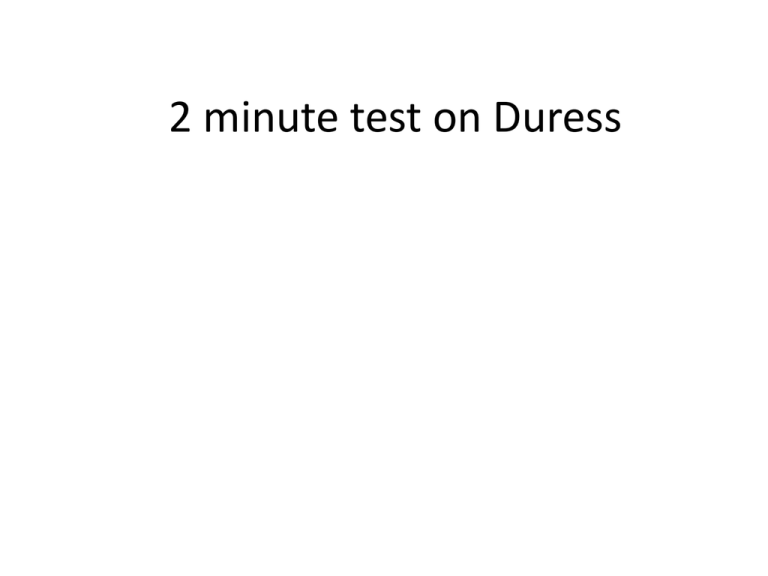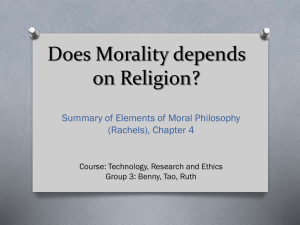Law and Morals
advertisement

2 minute test on Duress Law and Morals Write your own definition of a law and a rule on the Whiteboard. Rule: “a general norm mandating or guiding conduct” Twining and Miers Law: “the body of principles recognised and applied by the state in the administration of justice” Sir John Salmond “ Command issued from a sovereign power to an inferior and enforced by coercion” John Austin: The Province of Jurisprudence Hart’s approach to rules Defining charcteristic of a rule is its enforceability. They are obeyed for 1 of 3 reasons: 1) Moral Obligation Shaw V DPP (1962), Judges are the ultimate guardians of our morals and have a duty to act against immoral behaviour 2) Reasonable and relevant rule: Abandonment of ‘Poll Tax’ 3) Penalty imposed if rule is broken. Eg. Seatbelts Morality Morals: “ a set of beliefs, values, principles and standards of behaviour” Phil Harris Introduction to Law Moral values of communities lay down a framework for how people should behave. Eg. 10 commandments, good Samaritan law. Differs from individual to individual and culture to culture although some behaviour is universally unacceptable. Roots are often found in religion eg. Bible, Koran forms basis of sharia law. Moral rules • Compliance not required by state • Develop gradually over time often from religious rules by may adapt organically with society. Eg. Attitudes to homosexuality • Enforced informally through social or domestic pressure. Morality and Law • Law of country will generally reflect the moral values accepted by the majority of the people. However, Adultery morally unacceptable by both Christianity and Islam however it is not considered a crime in Christian Countries. However it is in some Muslim Countries. Morality in Practice • In England there has been a move away from religious beliefs impacting on law. • Eg. Abortion Act 1967 – Gillick V West Norfolk and Wisbech (1986) However it is still influential in some areas eg.Euthanasia (R (Pretty) V DPP (2001) and Re B (2000), R (Purdy) V DPP (2009) R V Cox (1992) and R V Arthur (1981) : Doctors assisting Airedale NHS Trust V Bland (1993): Medical staff can stop life support machine in patient was in a persistent vegetative state even if they could breathe unaided. Many consider this immoral as it denies the sanctity of life. Pluralism • How are we pluralist – – – – Cultures Races Political ideals Religious followings • Durkheim suggested that it is almost impossible to find a single set of moral values that would be acceptable to all the members of a modern society. • However core issues: Life and Death? Abortion Does every pregnant woman in the UK have the right to have an abortion? No, only if certain conditions are met: - Pregnancy more damaging to the woman or members of her family than termination - Foetal abnormality. - However, in the USA all women have a constitutional right to an abortion Roe V Wade (1973) Difference between law and morality Complete your card sort. Relationship between law and morals • Both normative: dictate behavioural expectations • There is usually an overlap to make obedience more likely • Moral viewpoints influential in law making • Liverpool care Pathway • Abortion Laws • Euthanasia Public Morality Judicial Change Public Morality Legislative reform Abortion Act 1967 Civil Partnerships Act 2004 Law reform Public Morality Race Relations Act 1976 Law reform Murder (Abolition of Death Penalty) Act 1965 Campaign Public Morality R V R(1991) Brown (1993) Divergence of legal & moral rules • Some legal rules appear to have no moral connection eg. Parking on yellow lines, driving at 75 mph • Some moral rules have little or no legal backing eg. Good samaritan rule. • Reasons for the divergence betwn. Legal and moral rules – Moral attitude not popular enough – More social harm may be created by legal intervention Hart-Devlin debate: 1957 Wolfenden committee: recommended the legalisation of prostitution and homosexuality. Professor Hart Approved findings of report. Should be clear line between morality and law Morality private judgement and state has no right to intervene. Wrong to punish those who have done no harm to others. Legal system should be based on logical ideas producing ‘correct’ decisions from rules Lord Devlin Society required the observance of certain moral principles which should be supported in spite of public opinion. Judges have a residual right to protect and preserve some sort of common morality (Shaw V DPP) Legal Enforcement of Morals Criminal Law Sexual offences: Strict liability underage sex (R V G, 2008) Homicide offences: Thou shalt not kill Theft Act: Thou shalt not steal Defences: DR, LC Intoxication (Kingston) Natural Law Theorists • Aristotle: Principles which governed the universe, and explained how it was structured, functioned and could be discovered through observation and power of human reason. • Aquinas: Man is able to discover truth of divine law through revelation, reflection and practical reasoning. If human law was a variance with divine law it was not legal but a corruption of the law Natural Law Theorists • Fuller: Any legal system is only valid if it conforms to certain procedural requirements, including the law must be understandable and that it must not be retrospective. • R V R (1991) - R V Crooks (2004) • Lord Lloyd: “What has remained constant is an assertion that there are principles of natural law… the essence of natural law may be said to lie in the constant assertion that there are objective moral principles which depend upon the nature of the universe and which can be discovered by reason” Positivists • Bentham: Rejected natural law theories as being ‘nonsense upon stilts’. • Natural law principles cannot be proven confuse legal/moral issues • Validity of law did not depend on whether it was good or bad • Promoted utility principle: greatest happiness for the greatest number • Austin: Law may be valid irrespective of moral content. • Command from sovereign, who bulk of society is in habit of obeying, enforced by sanction. Hart -Mill • The minority should not be made to conform to the will of the majority when in private, as this would amount to tyranny and be immoral. • Using law to enforce moral values was unnecessary, undesirable and morally unacceptable • • • • • Influence Sexual Offences Act 1967 Obscene Publications Act 1968 Gillick V Norfolk & Wisbech HA (1986) R V Emmettt (1999) Stephen-Devlin • Law shares a common morality and law should intervene to punish acts which offend shared morality whether done in public or private. Failure to intervene would result in the disintegration of society. • Influence • Gillick V Norfolk & Wisbech HA (1986) • Shaw V DPP • R V Brown Exam Question Discuss the extent to which morals have had a serious impact on the development of law. Use examples from criminal law or civil law or both in illustrating your answer Fault What do we mean by fault in a legal context? - Legal blame/responsibility - Mental intention of defendant - Reckless activity Does everyone have an automatic right to a divorce? No, only if certain conditions are met: For example proving: irretrievable breakdown Unreasonable behaviour Therefore fault must be proven Fault V Strict Liability • What is a strict liability offence? • These offences are usually concerned with protecting the public in general, eg regulations on sale of food/alcohol. • Protection of society is more important than imposing liability on an individual who may not be at fault in any way. • Pharmacutical Society V Storkwain Ltd (1986) • RVG Levels of Fault • Specific Intention eg. Murder • Recklessness eg. Manslaughter, OAPA s.47 • Negligence eg. Gross Negligent Manslaughter Criticisms • Is it right that intention to cause GBH is adequate intention for murder? Vickers (1957) Mitigating Fault • Defence of Mistake Williams (1987) • Defence of automatism • Reducing liability – Diminished responsibility – Loss of control Sentencing • Judges have discretion as to sentencing except in the case of murder and other offences where a minimum sentence is set. EG. Repeat serious offenders, drug dealing or burglary. • Murder- tariffs (CJA’2003) Minimum jail term before eligible for parole. • Remember also the mitigating factors Should there be liability without fault? • Acceptable if the purpose of the offence is maintaining standards • Allowences for blameworthiness can be made in sentencing (Baroness Wootton) Baroness Wooton • Where aim of criminal law is to prevent socially damaging actions question of motivation is irrelevant when deciding guilt. • Point of sentencing is the time at which the presence or absence of guilty intention Is all important. • The courts can deal with the offence according to the level of fault by imposing a sentence which is likely to prevent a recurrence of the forbidden act. Exam Question • Discuss whether liability in the law should be based on fault. Use examples from criminal and/or civil law to support your discussion. Balancing Conflicting Interests • Interests/rights of 1 individual and the interest of the majority may sometimes fall into conflict. • Concept of fault is wrongful interference of another persons rights/interests. Corresponding rights and duties • Individual has enforceable right this imposes a duty on others to acknowledge that right. • Eg. In criminal law right to safety/life and not be a victim. Right to property etc. • Sanctions imposed for breach of duty. Conflicting rights • Certain rights have limited protection because to exercise the right may interfere with another person’s interests. • Eg. Right to life of unborn child: Who has precedence Father or Mother’s wishes? • Paton V UK (1990) • AG Ref (No 3 of 1994) (1997) Rights of Victim Vs Rights of Defendant • If there is not a mens rea then the defendant is likely to be found guilty even though the AR of the crime occurred and infringed V’s rights. • Defendant cannot rely on any mistaken belief arising from voluntary intoxication. (O’Grady) Criminal Justice System Whose rights are being balanced? Balancing Individual rights and Public Interests • R V Brown and R V Wilson Crown Prosecution Service Likelihood of success and public interest Bail • General right to bail as accused is presumed innocent until proven guilty so should not be held in custody while awaiting trial Sentencing • Aims: – Punishment of offenders – Reform and rehabilitation of offenders – Protection of the public Exam Question • It is possible to argue that one man’s right involves another man’s duty; but because of the competing nature of rights it is possible also that not every right Is enforceable. • Using examples from criminal law, or civil law or both, consider whether or not the above statement is true.




